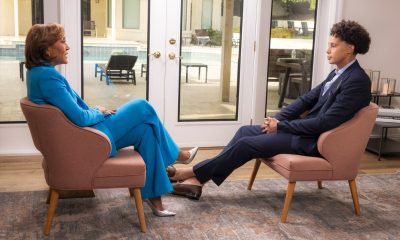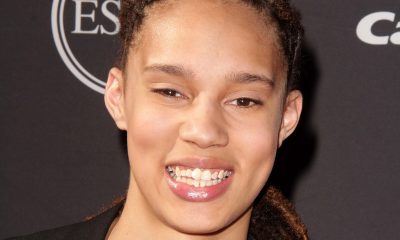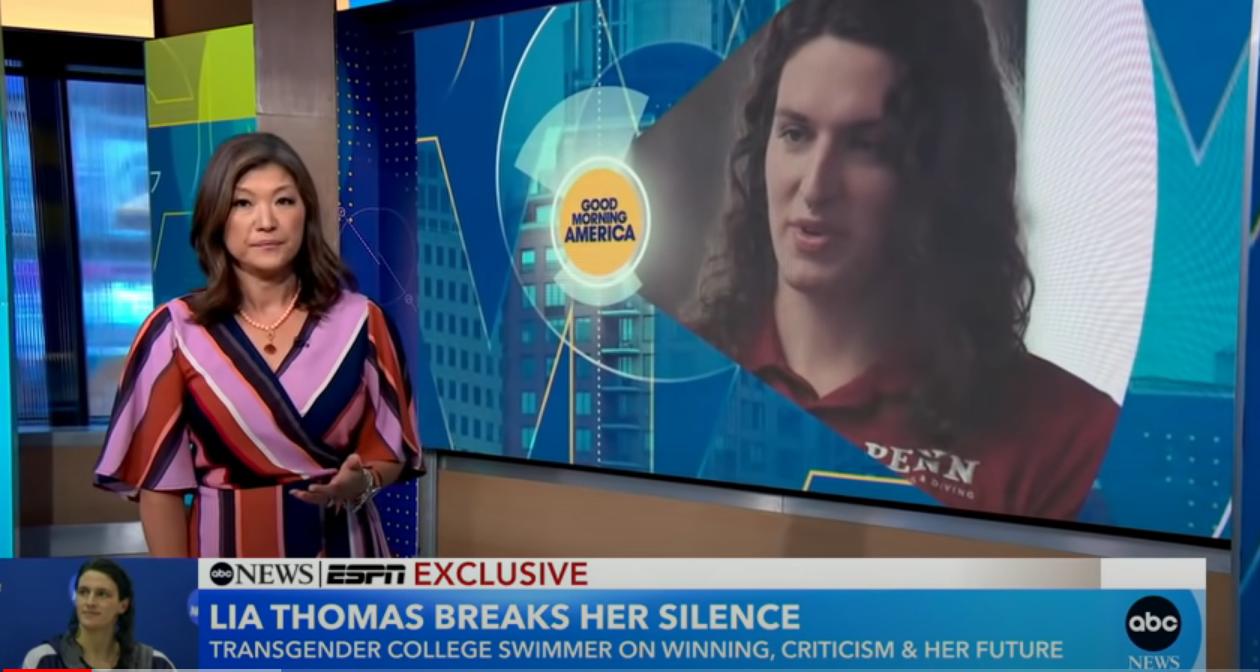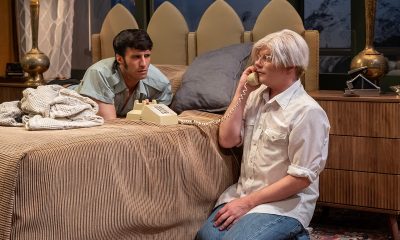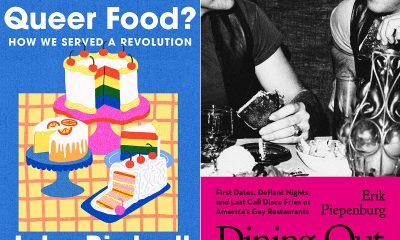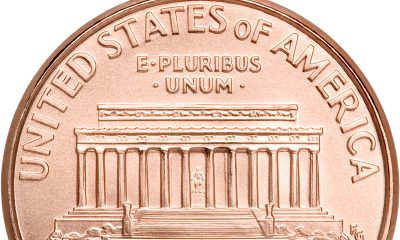a&e features
Gloria Gaynor celebrates ‘I Will Survive’ at Library of Congress festival
1978 classic is centerpiece for ‘Bibliodiscotheque’ event honoring disco era
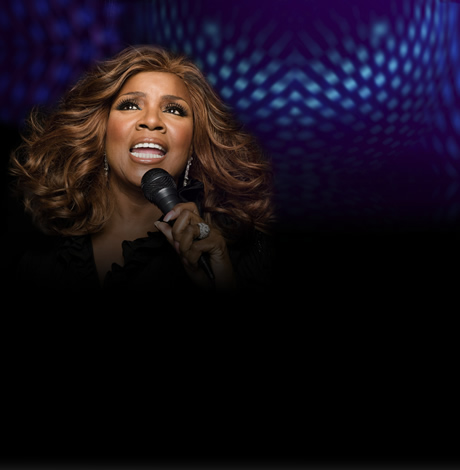

Gloria Gaynor says she used to see ‘I Will Survive’ as a mixed blessing but has come to embrace it as central to her mission to empower and uplift others. (Photo courtesy LOC)
‘Bibliodiscotheque’
Library of Congress
Continues through Saturday, May 6
SCHEDULE:
Friday, May 5:
Music & Veterans Panel Discussion
Noon in Whittall Pavilion
Saturday, May 6:
• ‘Bibliodiscotheque’ symposium with Gloria Gaynor, “Good Morning America” host Robin Roberts et. al. (1 p.m. in Coolidge Auditorium)
• “The Craft of Making Disco Balls” (1 p.m.)
• “Two Perspectives on Beyonce’s African Dance References” (1:30 p.m.)
• “Disco: the Bill Bernstein Photographs” (2 p.m.)
• “Hot Stuff: Disco and the Remaking of American Culture”
• panel discussion, 3 p.m.
• Robin Roberts interviews Gloria Gaynor (4 p.m.)
• Gloria Gaynor, et. al., book signing (5 p.m.)
• Gloria Gaynor in concert (7 p.m. in the Library of Congress Great Hall, sold out)
All events are free and open to the public but tickets must be secured in advance.
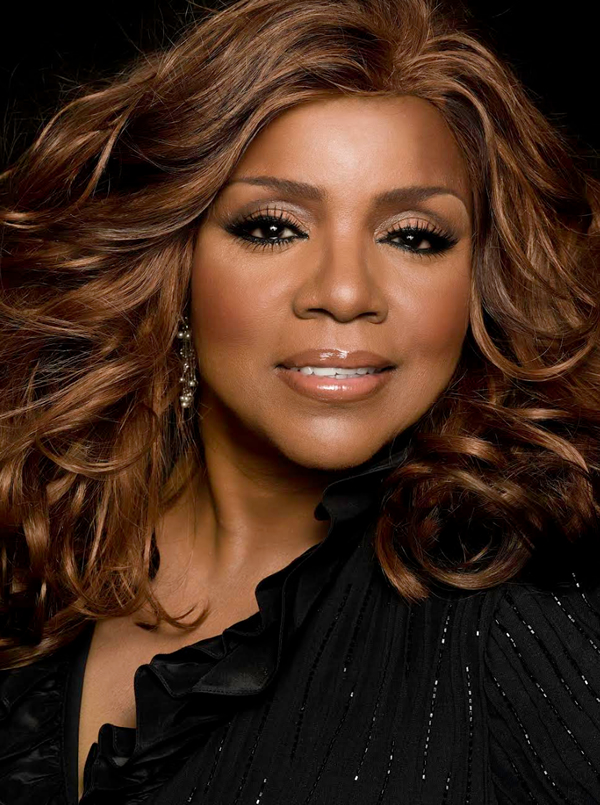
Gloria Gaynor (Photo courtesy LOC)
Gloria Gaynor cracked the U.S. Hot 100 several times throughout the 1970s but, of course, it’s her legendary 1978 No. 1 hit “I Will Survive” for which she’s most identified and remembered.
So universally beloved is the song that the Library of Congress has included it in its National Recording Registry, a list of sound recordings that have been deemed “culturally, historically or aesthetically important and/or inform or reflect life in the United States.” Begun in 2000, it includes everything from Scott Joplin piano rags, Bessie Smith blues, Roosevelt’s Fireside Chats, Abbott and Costello comedy routines and much more.
The Library wraps up its disco-tribute series ‘Bibliodiscotheque’ this weekend with an afternoon of events featuring Gaynor culminating with a free concert in the Great Hall. Gaynor spoke with the Blade by phone from her New Jersey home in March.
WASHINGTON BLADE: How do you feel about “I Will Survive” being inducted into the National Recording Registry and how did your involvement in this weekend’s festivities come about?
GLORIA GAYNOR: The song was inducted into the Library of Congress music registry last year and I honestly don’t know how it came about except that I got a message from my manager that they’d called and wanted to do this event. They first called her and said they were inducting the song and then they called a month later and said they wanted me to do this event, so who actually came up with the idea, it probably came out of the meeting we had with them, but I’ve forgotten now. But I was extremely happy about it. Flattered beyond belief.
BLADE: Had you ever been to the Library of Congress before?
GAYNOR: Not before that meeting. I went down and met with them and looked at the Thomas Jefferson building, the archives and oh my God, it’s an awesome building and an awesome room. It’s going to be acoustically a challenge for my sound people to do the concert there, but what a beautiful place, a beautiful room.
BLADE: When were you there?
GAYNOR: That was in November, I believe.
BLADE: You’ll also be signing copies of your 2013 book “We Will Survive: true Stories of Encouragement, Inspiration and the Power of Song.” What kind of reaction have you received from the book?
GAYNOR: A lot of people write and say how the book encouraged and inspired them, which was my whole purpose in writing the book because I’m thinking if you’re going through something, how encouraging, inspiring and uplifting would it be to read about someone who’s gone through what you’re going through or perhaps something even more difficult and yet they came out of the other side victorious? So when people call me and tell me the book or the song has accomplished my purpose, then of course that’s very encouraging, inspiring and uplifting to me.
BLADE: Why do you think the song still resonates so strongly all these years later?
GAYNOR: It taps into the tenacity of the human spirit. It encourages you and inspires you to reach down inside and pull up whatever support you have inside of you to get you through the difficult times in your life. … We all have situations, circumstances in our lives from time to time that we think are insurmountable and hope we’ll survive.
BLADE: Is it true it was originally slated to be the B-side? That seems inconceivable.
GAYNOR: Oh yes, absolutely. The record company had sent me to these producers out in California to record a song that the president of the company had chosen because he’d had a hit with it in England and wanted to repeat that success here in the United States and he specifically wanted me to help him do that so he sent me out to record that song which was called “Substitute.” And when I asked the producers what was going to be the B-side, they asked me in turn what kind of songs did I like, what kind of songs did I like to sing and record. I told them I like songs that are meaningful and that touch people’s hearts and have good melodies and they said, “Oh, we think you’re the one we’ve been waiting for to record this song that we wrote a couple years ago.”
BLADE: Did you realize right away it had strong hit potential?
GAYNOR: Well, the fact that my mother had passed away just a couple years prior and I never thought I’d survive that and the fact that I was standing there in a back brace from my hip up to my art pit because I’d fallen on stage and woke up the next morning paralyzed from the waist down and was in the hospital for four years wondering what was going to happen to my life, I immediately related to the lyrics and immediately believed that since I was relating a couple of situations to the song that had nothing to do with the unrequited love that the song speaks about, I believed other people would do the same thing. I believed it was a timeless lyric that everybody was going to be able to relate to and time has proven me right.
BLADE: There was such a backlash against disco for years. When did you start seeing it appreciated again? Was that in the ‘90s?
GAYNOR: I always believed when people pulled away from it, that was something that was engineered and was more of an economic decision on the part of people whose bottom line was being negatively affected by the fact that people were buying so much disco music and they probably thought this was taking away from people buying their music so I think they came up with this idea for this big rally in Comiskey Park (in Chicago in 1979) but of course my question has always been if all those people who burned all those disco records hated disco music so much, why did they have those records to start with?
BLADE: It seems like it takes a long period after any pop musical genre is super popular — doo-wop, new wave, whatever — to be revived in a nostalgic way. Do you think it was any different with disco or pretty much the same phenomenon?
GAYNOR: Well I think it was a similar thing, but I don’t think it was that incident that caused it. I think that disco music very unfairly became associated with negative things like drugs and all different kinds of overindulgences and I think that contrary to what people believe, California, Miami and New York don’t run the world, middle America runs the world and middle America said I don’t want my children associated with that, so that was the end of it. It wasn’t really the end of it, but it went more into the underground and went more into the dance music that we have today.
BLADE: What’s your favorite cover of “I Will Survive”?
GAYNOR: Chantay Savage.
BLADE: Why?
GAYNOR: Because she’s the only one who really made it her own. She really changed it and made it her own and did a good job of it.
BLADE: How did it come about that you sang it with Diana Ross at her concert in New Jersey in 2013?
GAYNOR: A friend of mine asked me to go to the concert with her. I didn’t know that she had it in the back of her mind that was she using me to try to meet Diana Ross, but that’s what she did. She had called the management of the theater, I don’t know which now, but she got us really great seats using my name and then they came and got us — I don’t know if she asked for me to meet her or how it went, but that’s how we got backstage. They came and got us from our seats just before the show was over and then Diana Ross invited me onstage, which I never expected. I just thought we were standing there, she was going to come back and say hi, my friend’s gonna get her autograph and we’ll be on our way. But she did invite me on stage and I was very flattered and I thought it was really gracious of her to do that and we had a good time. The audience was ecstatic.
BLADE: Her ‘90s cover was just sort of a modest hit but nothing huge yet she’s been closing all her concerts with it for the last several years. Why do you think she keeps doing that when she had so many big hits of her own that would work in that slot in her show? Any theory on that?
GAYNOR: Well I don’t really need a theory on it because I have the truth of it. My brother was her chauffeur and bodyguard for 15 years and he told me that she said she always wished she’d recorded that song. She just liked it and she’s adopted it.
BLADE: Do you ever feel like maybe she’s hoping casual fans will forget it wasn’t she who had the big hit with it in the ‘70s or that she just likes it?
GAYNOR: I think she just does it because she likes it. She thinks it’s a great song.
BLADE: Was it ever challenging for you to reconcile your Christian faith with being open on gay issues or to gay fans?
GAYNOR? No.
BLADE: Did gays and straights mix more in the disco clubs back in the ‘70s or do you recall?
GAYNOR: Well, we all know that there are gay clubs. At my concerts it was always mixed. It was never just all gay or all straight. It was always mixed.
BLADE: Did gays embrace “I Will Survive” right away or that something that grew over the years?
GAYNOR: I honestly don’t know. When they came to the concerts, as I said, it was always mixed. I don’t really separate my fans into categories and see who’s liking what. My fans are just my fans and they like me and whatever I sing, whatever it is. Some, of course, there are certain songs that certain individuals like more than others because they relate to them more than others, but I don’t think any particular group related more to “I Will Survive” more than any other group because it’s a song about human problems, human trauma.
BLADE: But “I Will Survive” is sort of the ultimate shorthand for gay anthem. It’s been voted the top gay anthem of all time by various publications. Did that come about more after the AIDS years perhaps?
GAYNOR: I really don’t know.
BLADE: You’re a native of Newark, New Jersey, but you were obviously already famous and traveling often when Whitney Houston was coming up. Did you know she and Cissy in Newark when Whitney was growing up?
GAYNOR: I knew (Cissy) as an artist I admired and went to see, but I didn’t know her personally. I met Whitney, you know, after she became famous and we had a mutual admiration for one another. She told me on a number of occasions how inspiring I was to her and how she would pull out my song whenever she was feeling down. She looked up to me and admired me and thanked me for being a positive influence in her life.
BLADE: What’s your favorite hymn or gospel song?
GAYNOR: One that was originally called “I Will Survive” but I recorded it and changed the title so people wouldn’t think it was the same song. Now it’s called “He Gave Me Life.”
BLADE: Have you kept all your career mementos? Do you have clippings and gowns and all that?
GAYNOR: Some, yeah. I’ve kept some clippings and gowns but most of my gowns I’ve given away to friends who are in the music business. That’s primarily what I’ve done. If I’m not using something, I’d rather see someone use it.
BLADE: About how much of the year do you travel?
GAYNOR: Now I’m not traveling as much. I’ve slowed down on purpose. It used to be that I was rarely home for more than two weeks at a time but I was rarely gone for more than two weeks at a time, too. Now it’s more like I’m going out maybe once a month, twice a month. Maybe two or three shows a month.
BLADE: You had other hits but “I Will Survive” has become so much more than just a hit record. Some singers feel it’s a blessing and a curse to be so heavily identified with one song. How do you see it?
GAYNOR: I used to see it as a double-edged sword because I recorded so many other songs that in my opinion are great songs, but I’ve come to understand that this song is the core of my God-given purpose and it’s fine, I’m very pleased for it and I’m very happy for it. I just really believe that God said, you know, I want you to have this, I want you to do this with it, I want you to use it to uplift, encourage and empower people with this song and I am very happy and honored for this purpose. I’m very honored for the opportunity and a kind of responsibility to do that for people and it’s wonderful when people come to me and tell me that this song has encouraged them. And the wonderful thing about it is they don’t just say this song did this for me, they say you did this for me. So it adds meaning and purpose to my life and it’s still very, very encouraging and uplifting for me.
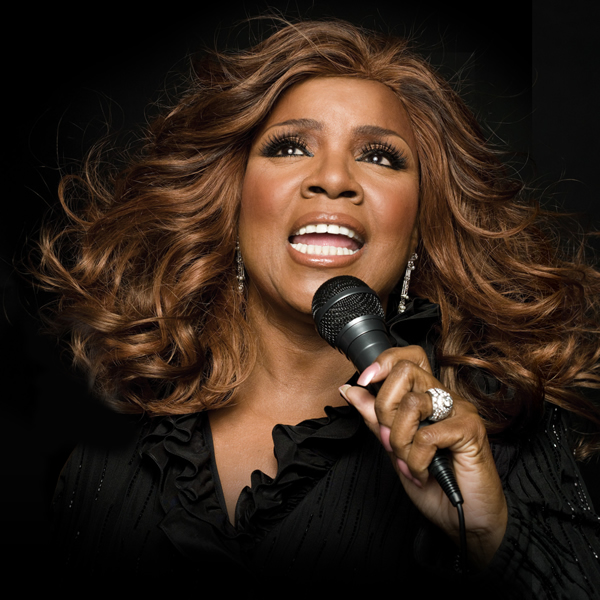
Gloria Gaynor (Photo courtesy LOC)
a&e features
Doug Spearman takes his chance
‘Noah’s Arc: The Movie’ debuted on Paramount+ last month
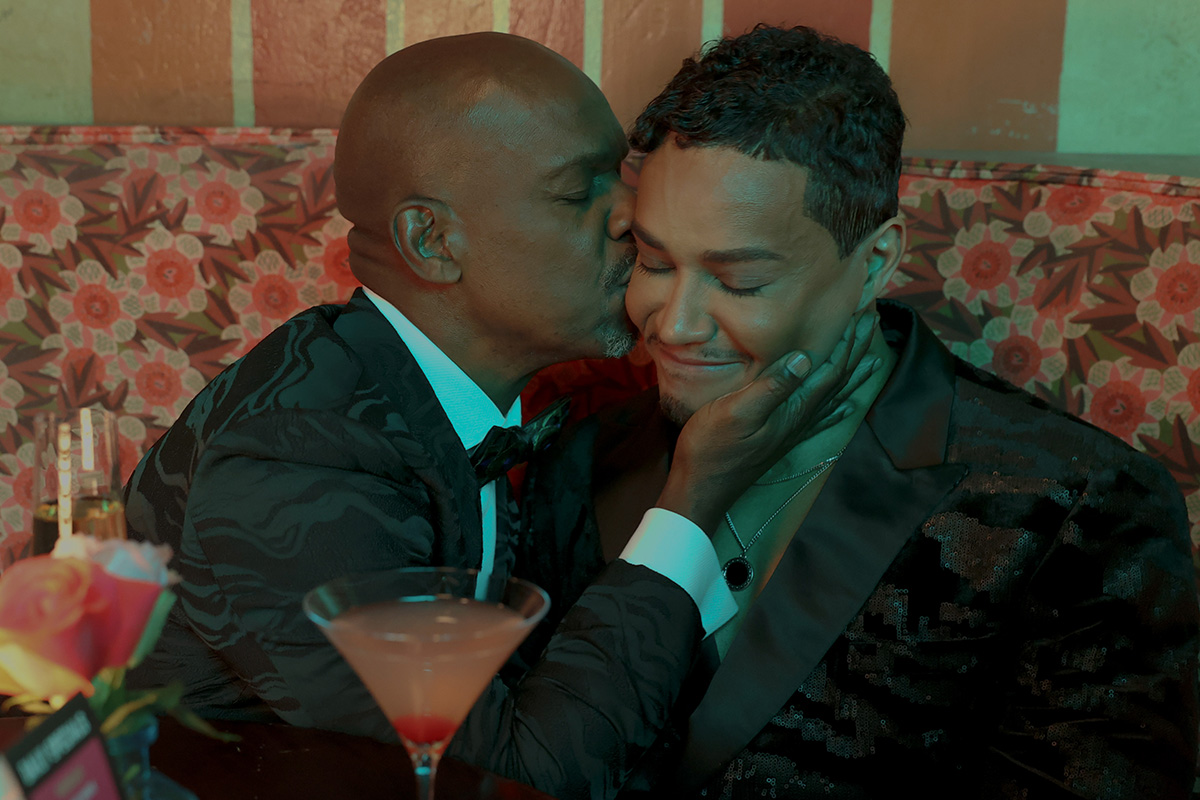
There’s no question that when Patrik-Ian Polk’s series “Noah’s Arc” premiered on Logo 20 years ago, it was a groundbreaking creation. The story of a group of Black gay men and their wonderful friendship. The titular arc was that of the cute main character, Noah (Darryl Stephens), and his close-knit circle of friends, including Chance played by gay actor Doug Spearman. This compelling and loving fraternity may, in fact, be what brought viewers back repeatedly, including a 2008 movie, “Noah’s Arc: Jumping the Broom,” as well as the 2020 “Noah’s Arc” short, and now, a new full-length feature “Noah’s Arc: The Movie,” debuting on Paramount+ on June 20. In the movie, filled with equal measures of laughs and tears, Chance, who has faced a devastating loss, finds his dependable friends there, ready to support and comfort him at a moment’s notice. I had the pleasure of speaking with Spearman the morning of the streaming premiere of “Noah’s Arc: The Movie.”
WASHINGTON BLADE: Doug, since the early 2000s, when the “Noah’s Arc” series premiered on Logo, you have been playing the character of Chance, including in the latest installment, “Noah’s Arc: The Movie.” What was it about Chance that appealed to you as an actor?
SPEARMAN: When Patrik (-Ian Polk) called me to ask me to play him (Chance), I was at JFK airport in the baggage claim, waiting for a suitcase. He explained what the part was. The thing that stuck out to me was the fact that Chance was in a long-term relationship with another Black man. And, they had a child; they had a 4-year-old daughter named Kenya. I had never seen two Black gay men raise a child on TV before. I thought it was the most revolutionary thing I’d ever seen. I immediately thought I’ve got to do this because that was something nobody had seen. I thought it was incredibly important to take the part.
BLADE: “Noah’s Arc: The Movie” was, once again, written and directed by Patrik-Ian Polk, who you just mentioned, is the creator of the entire franchise. What’s the secret to your long-standing working relationship?
SPEARMAN: [Laughs] the whole team, all of us, are like a band of brothers. We fight like brothers, we come together like brothers, we hash things out, we talk, because we’re all very different from our characters. I think the challenge of playing these guys and then uplifting these men, playing a part, especially something written by Patrik, is like solving a math equation. There’s always a challenge that’s enjoyable for me as an actor: to try to find out what it is that Patrik wants, and then how do I do it.
BLADE: I think you do a very good job of it.
SPEARMAN: Thank you very much
BLADE: In the years between “Jumping the Broom” and the new full-length movie, many changes have occurred, and the story addresses some of them, including gay widowhood, which is something that the aging community is now confronting, as well as mental health issues. Please say a few words about how you approached those subjects in the new movie.
SPEARMAN: I had a lot of loss in my life, right before we started shooting. Two months before we started shooting the first series, my mother died. I was going through the grief process through that whole first season. Since then, I’ve lost a lot of people in my life. In fact, when we started shooting the second season, the second week we were shooting, my ex died of a heart attack. I was having to fold that into what I was doing with my life on the set and off the set. You’ve got to show up and you’ve got to do your work. The first two seasons of “Noah’s Arc” are always tinged with the memory of grief. So, when I had to deal with the death that Chance faces (in the new movie), which is a significant death in his life, it wasn’t that hard to reach back, especially the scene in the graveyard. It was something that I unfortunately could pull from personal experience.
BLADE: Shifting gears, the movie features delightful cast surprises, including Jasmine Guy and TS Madison. Did you have a chance to interact with either or both when they were on set?
SPEARMAN: No, I didn’t have any scenes with Jasmine, and I missed her. I wish I had gotten to see her because I actually got to direct Jasmine for a CBS promo shoot for “Queen,” back in the early ‘90s. I had a huge crush on her when she was on “A Different World.” So, I really would have liked to reconnect. But TS and I got to see each other every day because I was in all her scenes. It was extraordinary being around somebody like that. That is one outspoken woman!
BLADE: Even though Beyoncé never makes an appearance in the movie, there’s a lot of talk about her. Would you say you are a Beyoncé fan?
SPEARMAN: Yes! I’m breathing! Yes, I’m a Beyoncé fan. I actually got the chance to meet her. I knew her mom. Her mom was extraordinary to me. She is in the second movie I directed. She also gave us a wedding gown to use in the very first scene of the movie. That family is extraordinarily important to me. Not only just to be a fan, but to be somebody who’s gotten to know them and work with them and see how hard they work. I don’t think anybody works as hard as Tina or Beyoncé.
BLADE: There was a recent news item about gay actor Benito Skinner of the Amazon Prime series “Overcompensating” being told not to bother auditioning for straight roles. As an out actor yourself, how important do you think it is for queer characters to be portrayed by queer actors, and vice versa?
SPEARMAN: Being queer is a multifaceted identity. There’s no one kind of queer person. I think finding the best actor that’s your first circle of casting. I think one of the joys about being an actor is that you get to play different parts. I play straight guys all the time. Dads and husbands and things like that. I think a lot of people are told not to do it. In fact, I wouldn’t be Chance if the actor who was originally cast as Chance hadn’t been pulled out of the series by his agents because they didn’t want him to play a gay character.
BLADE: That’s amazing! Thank you for sharing that. Without giving away too much, the ending of the movie is a little ambiguous, even ending with a question mark. If there was a “Noah’s Arc: The Movie” sequel, would you come back for that?
SPEARMAN: Yeah! A lot of it would depend on what Chance’s journey is going to be like. Patrik and I have conversations like that all the time. He’s very interested and supportive of input. I hope I would be, as we all would be, part of the creative growth with these characters. They live in Patrik’s head, and he writes them, but we’re the ones who have to flesh them out. It’s a conversation, it’s always a conversation.
BLADE: You are currently performing in Molière’s “The Imaginary Invalid” as part of the New Orleans Shakespeare Festival at Tulane. What has this experience been like for you?
SPEARMAN: It’s extraordinary! I started on stage when I was seven. There’s nothing like working with a live audience and having that immediacy. I’m working with an extraordinarily talented cast in a really great play, and I have some of the best scene partners I could ever want.
BLADE: Are there any upcoming film or TV projects you’d like to mention?
SPEARMAN: I’m still a writer, and I’m still a director, and I’ve still got scripts that I would like to make. I have a little something that’s a cross between “Treme” and “Bridgerton” that I want to do. I’m always trying to figure out what the next thing is.
a&e features
Visit Cambridge, a ‘beautiful secret’ on Maryland’s Eastern Shore
New organization promotes town’s welcoming vibe, LGBTQ inclusion
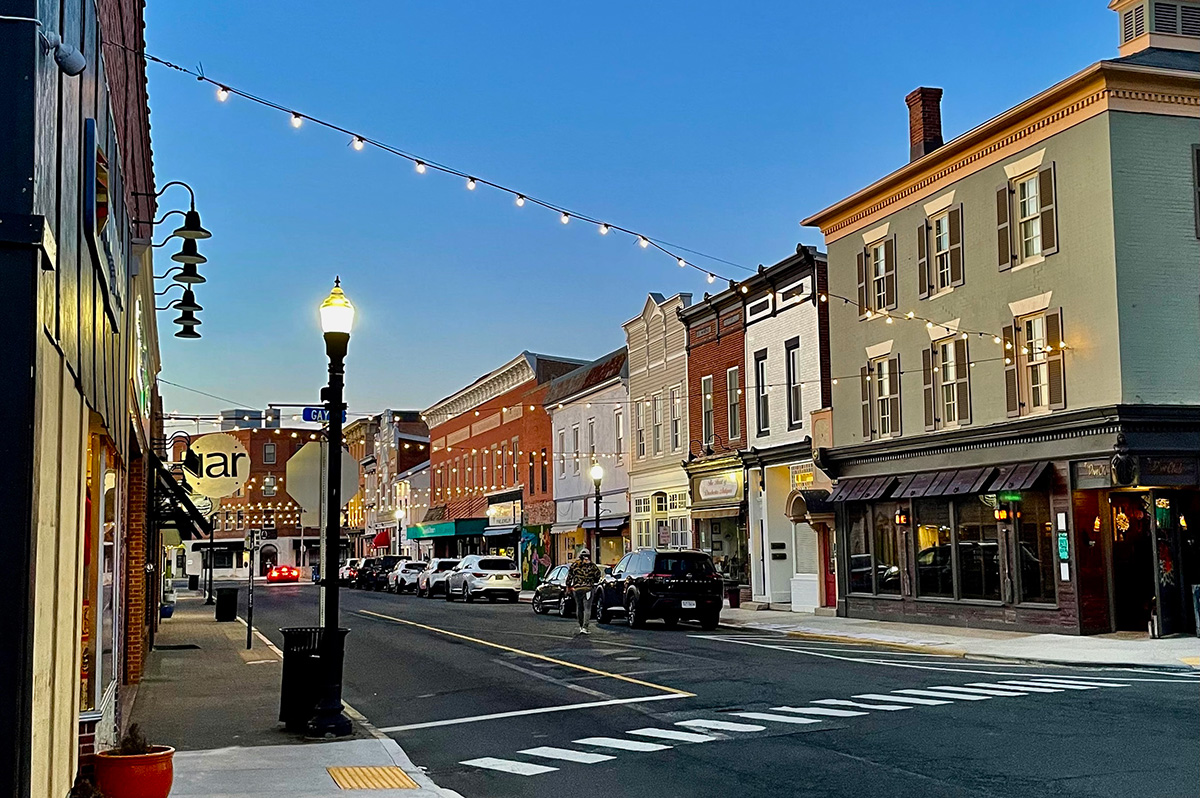
CAMBRIDGE, Md. — Driving through this scenic, historic town on Maryland’s Eastern Shore, you’ll be charmed by streets lined with unique shops, restaurants, and beautifully restored Victorian homes. You’ll also be struck by the number of LGBTQ Pride flags flying throughout the town.
The flags are a reassuring signal that everyone is welcome here, despite the town’s location in ruby red Dorchester County, which voted for Donald Trump over Kamala Harris by a lopsided margin. But don’t let that deter you from visiting. A new organization, Proudly Cambridge, is holding its debut Pride event this weekend, touting the town’s welcoming, inclusive culture.
“We stumbled on a beautiful secret and we wanted to help get the word out,” said James Lumalcuri of the effort to create Proudly Cambridge.
The organization celebrates diversity, enhances public spaces, and seeks to uplift all that Cambridge has to share, according to its mission statement, under the tagline “You Belong Here.”
The group has so far held informal movie nights and a picnic and garden party; the launch party is June 28 at the Cambridge Yacht Club, which will feature a Pride celebration and tea dance. The event’s 75 tickets sold out quickly and proceeds benefit DoCo Pride.
“Tickets went faster than we imagined and we’re bummed we can’t welcome everyone who wanted to come,” Lumalcuri said, adding that organizers plan to make “Cheers on the Choptank” an annual event with added capacity next year.
One of the group’s first projects was to distribute free Pride flags to anyone who requested one and the result is a visually striking display of a large number of flags flying all over town. Up next: Proudly Cambridge plans to roll out a program offering affirming businesses rainbow crab stickers to show their inclusiveness and LGBTQ support. The group also wants to engage with potential visitors and homebuyers.
“We want to spread the word outside of Cambridge — in D.C. and Baltimore — who don’t know about Cambridge,” Lumalcuri said. “We want them to come and know we are a safe haven. You can exist here and feel comfortable and supported by neighbors in a way that we didn’t anticipate when we moved here.”
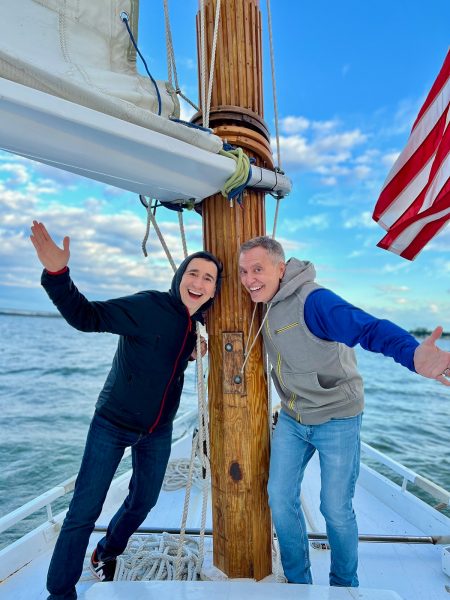
Lumalcuri, 53, a federal government employee, and his husband, Lou Cardenas, 62, a Realtor, purchased a Victorian house in Cambridge in 2021 and embarked on an extensive renovation. The couple also owns a home in Adams Morgan in D.C.
“We saw the opportunity here and wanted to share it with others,” Cardenas said. “There’s lots of housing inventory in the $300-400,000 range … we’re not here to gentrify people out of town because a lot of these homes are just empty and need to be fixed up and we’re happy to be a part of that.”
Lumalcuri was talking with friends one Sunday last year at the gazebo (affectionately known as the “gayzebo” by locals) at the Yacht Club and the idea for Proudly Cambridge was born. The founding board members are Lumalcuri, Corey van Vlymen, Brian Orjuela, Lauren Mross, and Caleb Holland. The group is currently working toward forming a 501(c)3.
“We need visibility and support for those who need it,” Mross said. “We started making lists of what we wanted to do and the five of us ran with it. We started meeting weekly and solidified what we wanted to do.”
Mross, 50, a brand strategist and web designer, moved to Cambridge from Atlanta with her wife three years ago. They knew they wanted to be near the water and farther north and began researching their options when they discovered Cambridge.
“I had not heard of Cambridge but the location seemed perfect,” she said. “I pointed on a map and said this is where we’re going to move.”
The couple packed up, bought a camper trailer and parked it in different campsites but kept coming back to Cambridge.
“I didn’t know how right it was until we moved here,” she said. “It’s the most welcoming place … there’s an energy vortex here – how did so many cool, progressive people end up in one place?”
Corey van Vlymen and his husband live in D.C. and were looking for a second home. They considered Lost River, W.Va., but decided they preferred to be on the water.
“We looked at a map on both sides of the bay and came to Cambridge on a Saturday and bought a house that day,” said van Vlymen, 39, a senior scientist at Booz Allen Hamilton. They’ve owned in Cambridge for two years.
They were drawn to Cambridge due to its location on the water, the affordable housing inventory, and its proximity to D.C.; it’s about an hour and 20 minutes away.
Now, through the work of Proudly Cambridge, they hope to highlight the town’s many attributes to residents and visitors alike.
“Something we all agree on is there’s a perception problem for Cambridge and a lack of awareness,” van Vlymen said. “If you tell someone you’re going to Cambridge, chances are they think, ‘England or Massachusetts?’”
He cited the affordability and the opportunity to save older, historic homes as a big draw for buyers.
“It’s all about celebrating all the things that make Cambridge great,” Mross added. “Our monthly social events are joyful and celebratory.” A recent game night drew about 70 people.
She noted that the goal is not to gentrify the town and push longtime residents out, but to uplift all the people who are already there while welcoming new visitors and future residents.
They also noted that Proudly Cambridge does not seek to supplant existing Pride-focused organizations. Dorchester County Pride organizes countywide Pride events and Delmarva Pride was held in nearby Easton two weeks ago.
“We celebrate all diversity but are gay powered and gay led,” Mross noted.
To learn more about Proudly Cambridge, visit the group on Facebook and Instagram.
What to see and do
Cambridge, located 13 miles up the Choptank River from the Chesapeake Bay, has a population of roughly 15,000. It was settled in 1684 and named for the English university town in 1686. It is home to the Harriet Tubman Museum, mural, and monument. Its proximity to the Blackwater National Wildlife Refuge makes it a popular stop for birders, drawn to more than 27,000 acres of marshland dubbed “the Everglades of the north.”
The refuge is walkable, bikeable, and driveable, making it an accessible attraction for all. There are kayaking and biking tours through Blackwater Adventures (blackwateradventuresmd.com).
Back in town, take a stroll along the water and through historic downtown and admire the architecture. Take in the striking Harriet Tubman mural (424 Race St.). Shop in the many local boutiques, and don’t miss the gay-owned Shorelife Home and Gifts (421 Race St.), filled with stylish coastal décor items.
Stop for breakfast or lunch at Black Water Bakery (429 Race St.), which offers a full compliment of coffee drinks along with a build-your-own mimosa bar and a full menu of creative cocktails.
The Cambridge Yacht Club (1 Mill St.) is always bustling but you need to be a member to get in. Snapper’s on the water is temporarily closed for renovations. RaR Brewing (rarbrewing.com) is popular for craft beers served in an 80-year-old former pool hall and bowling alley. The menu offers burgers, wings, and other bar fare.
For dinner or wine, don’t miss the fantastic Vintage 414 (414 Race St.), which offers lunch, dinner, wine tasting events, specialty foods, and a large selection of wines. The homemade cheddar crackers, inventive flatbreads, and creative desserts (citrus olive oil cake, carrot cake trifle) were a hit on a recent visit.
Also nearby is Ava’s (305 High St.), a regional chain offering outstanding Italian dishes, pizzas, and more.
For something off the beaten path, visit Emily’s Produce (22143 Church Creek Rd.) for its nursery, produce, and prepared meals.
“Ten minutes into the sticks there’s a place called Emily’s Produce, where you can pay $5 and walk through a field and pick sunflowers, blueberries, you can feed the goats … and they have great food,” van Vlymen said.
As for accommodations, there’s the Hyatt Regency Chesapeake Bay (100 Heron Blvd. at Route 50), a resort complex with golf course, spa, and marina. Otherwise, check out Airbnb and VRBO for short-term rentals closer to downtown.
Its proximity to D.C. and Baltimore makes Cambridge an ideal weekend getaway. The large LGBTQ population is welcoming and they are happy to talk up their town and show you around.
“There’s a closeness among the neighbors that I wasn’t feeling in D.C.,” Lumalcuri said. “We look after each other.”
a&e features
James Baldwin bio shows how much of his life is revealed in his work
‘A Love Story’ is first major book on acclaimed author’s life in 30 years

‘Baldwin: A Love Story’
By Nicholas Boggs
c.2025, FSG
$35/704 pages
“Baldwin: A Love Story” is a sympathetic biography, the first major one in 30 years, of acclaimed Black gay writer James Baldwin. Drawing on Baldwin’s fiction, essays, and letters, Nicolas Boggs, a white writer who rediscovered and co-edited a new edition of a long-lost Baldwin book, explores Baldwin’s life and work through focusing on his lovers, mentors, and inspirations.
The book begins with a quick look at Baldwin’s childhood in Harlem, and his difficult relationship with his religious, angry stepfather. Baldwin’s experience with Orilla Miller, a white teacher who encouraged the boy’s writing and took him to plays and movies, even against his father’s wishes, helped shape his life and tempered his feelings toward white people. When Baldwin later joined a church and became a child preacher, though, he felt conflicted between academic success and religious demands, even denouncing Miller at one point. In a fascinating late essay, Baldwin also described his teenage sexual relationship with a mobster, who showed him off in public.
Baldwin’s romantic life was complicated, as he preferred men who were not outwardly gay. Indeed, many would marry women and have children while also involved with Baldwin. Still, they would often remain friends and enabled Baldwin’s work. Lucien Happersberger, who met Baldwin while both were living in Paris, sent him to a Swiss village, where he wrote his first novel, “Go Tell It on the Mountain,” as well as an essay, “Stranger in the Village,” about the oddness of being the first Black person many villagers had ever seen. Baldwin met Turkish actor Engin Cezzar in New York at the Actors’ Studio; Baldwin later spent time in Istanbul with Cezzar and his wife, finishing “Another Country” and directing a controversial play about Turkish prisoners that depicted sexuality and gender.
Baldwin collaborated with French artist Yoran Cazac on a children’s book, which later vanished. Boggs writes of his excitement about coming across this book while a student at Yale and how he later interviewed Cazac and his wife while also republishing the book. Baldwin also had many tumultuous sexual relationships with young men whom he tried to mentor and shape, most of which led to drama and despair.
The book carefully examines Baldwin’s development as a writer. “Go Tell It on the Mountain” draws heavily on his early life, giving subtle signs of the main character John’s sexuality, while “Giovanni’s Room” bravely and openly shows a homosexual relationship, highly controversial at the time. “If Beale Street Could Talk” features a woman as its main character and narrator, the first time Baldwin wrote fully through a woman’s perspective. His essays feel deeply personal, even if they do not reveal everything; Lucian is the unnamed visiting friend in one who the police briefly detained along with Baldwin. He found New York too distracting to write, spending his time there with friends and family or on business. He was close friends with modernist painter Beauford Delaney, also gay, who helped Baldwin see that a Black man could thrive as an artist. Delaney would later move to France, staying near Baldwin’s home.
An epilogue has Boggs writing about encountering Baldwin’s work as one of the few white students in a majority-Black school. It helpfully reminds us that Baldwin connects to all who feel different, no matter their race, sexuality, gender, or class. A well-written, easy-flowing biography, with many excerpts from Baldwin’s writing, it shows how much of his life is revealed in his work. Let’s hope it encourages reading the work, either again or for the first time.

